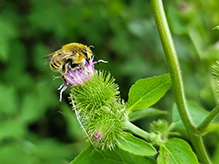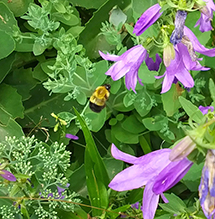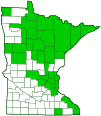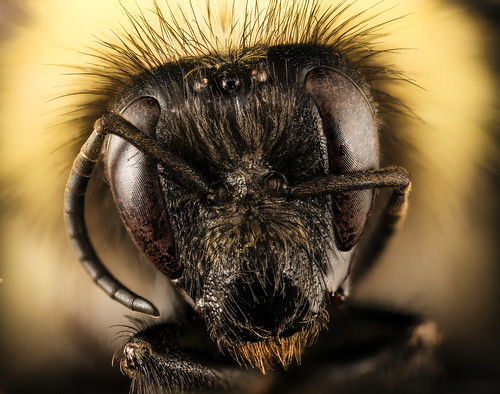confusing bumble bee
(Bombus perplexus)
Conservation • Description • Habitat • Ecology • Distribution • Taxonomy
Conservation Status |
|
|||||||
| IUCN Red List | LC - Least Concern |
|||||||
| NatureServe | N5 - Secure SNR - Unranked |
|||||||
| Minnesota | not listed |
|||||||
Description |
||
Confusing bumble bee is a small bumble bee. It occurs in Alaska, across southern Canada, and in the eastern United States. In Minnesota it is common in the metro, northeast, and north-central regions, but absent from the southwestern third of the state. It is found from April to September visiting flowers in forests, woodlands, urban parks, gardens, and wetlands. It is a generalist feeder, visiting a wide variety of flowers in many plant families. It usually nests underground, sometimes in hollow logs. The female (worker) bee is ½″ to 9⁄16″ (12 to 14 mm) long. The color pattern of the hairs (pubescence) is variable. The hairs on the head are mostly black. There is a dense band of yellow hairs on top of the head (vertex) at the rear. There are two large compound eyes, one on each side of the head, and three small simple eyes (ocelli) in a triangular pattern at the top of the head between the compound eyes. The antennae have 12 segments consisting of one basal segment (scape), one small connecting segment (pedicel), and ten more segments (flagellomeres). The scape is long, slightly more than half as long as all of the flagellomeres together. The first flagellomere is much longer than the third. The second is much longer than wide. The third is slightly longer than the second. The space below the compound eye (malar space) is smooth and shiny. The tongue is medium length. The upper side of the thorax is densely covered with relatively long, yellow hairs. Unlike other bumble bees, there are no black hairs or bare spot in the middle. The hairs on the sides are often dark. On the underside, one-third to one-half of the thorax is entirely black. The abdomen has six segments and is densely covered with relatively long hairs. The first and second segments are entirely yellow. The third segment may be entirely black or yellow in the middle becoming black toward the sides. Segments 4 through 6 are black with some paler hairs intermixed, especially so on segment 6. The wings are lightly brownish tinged. The veins are pale brick red to brownish-black. The legs are black and are covered with black hairs. The queen is similar but larger. The pubescence is shorter and less dense. Abdominal segments 3 to 6 are black, but segment 6 sometimes has some pale hairs intermixed. The male (drone) is ½″ to 9⁄16″ (13 to 14 mm) in length. It is similar to the worker but the abdomen has 7 segments and the antennae have 13 segments. Abdominal segments 1 through 3 are yellow. The hairs on the legs are yellow. The fourth segment (tibia) on the hind leg is distinctly shiny. |
||
Size |
||
Male: ½″ to 9⁄16″ (13 to 14 mm) Worker: ½″ to 9⁄16″ (12 to 14 mm) Queen: ⅝″ to 13⁄16″ (17 to 21 mm) |
||
Similar Species |
||
Habitat |
||
Forests, woodlands, urban parks, gardens, and wetlands. |
||
Ecology |
||
Season |
||
April to September |
||
Behavior |
||
|
||
Life Cycle |
||
The queen lays eggs individually in separate cells. |
||
Larva Food |
||
Larvae are fed both nectar for carbohydrates and pollen for protein. |
||
Adult Food |
||
Adults feed mostly on nectar but also on some pollen. |
||
Distribution |
||||
|
Sources |
|||
| 8/12/2022 | ||||
Occurrence |
||||
|
||||
Taxonomy |
|||
Order |
Hymenoptera (Ants, Bees, Wasps, and Sawflies) | ||
Suborder |
Apocrita (Narrow-waisted Wasps, Ants, and Bees) | ||
Infraorder |
Aculeata (Ants, Bees, and Stinging Wasps) | ||
Superfamily |
Apoidea (Bees and Apoid Wasps) | ||
| Epifamily | Anthophila (bees) | ||
Family |
Apidae (honey bees, bumble bees, and allies) | ||
Subfamily |
Apinae (honey, bumble, longhorn, orchid, and digger bees) | ||
Tribe |
Bombini | ||
Genus |
Bombus (bumble bees) | ||
| Subgenus | Pyrobombus | ||
Some authors separate bumble bees and orchid bees into the subfamily Bombinae. NCBI follows this classification. Most authors follow Michener (2007) and include those groups in the subfamily Apinae with the honey bees. |
|||
Synonyms |
|||
Apathus dorsalis Bombus hudsonicus |
|||
Common Names |
|||
confusing bumble bee perplexing bumble bee |
|||
Glossary
Flagellomere
A segment of the whip-like third section of an insect antenna (flagellum).
Malar space
In Hymenoptera, the space, equivalent to the cheek, between the bottom of the compound eye and the base of the mandible.
Ocellus
Simple eye; an eye with a single lens. Plural: ocelli.
Pubescence
On plants: the fuzzy hairs on a leaf, bud, stem, fruit, flower, or other structure. On insects and arachnids: the hair-like processes (setae) on the body.
Scape
In plants: An erect, leafless stalk growing from the rootstock and supporting a flower or a flower cluster. In insects: The basal segment of the antenna.
Tibia
The fourth segment of an insect leg, after the femur and before the tarsus (foot). The fifth segment of a spider leg or palp. Plural: tibiae.
vertex
The upper surface of an insect’s head.
Visitor Photos |
|||||
Share your photo of this insect. |
|||||
| This button not working for you? Simply email us at info@MinnesotaSeasons.com. Attach one or more photos and, if you like, a caption. |
|||||
Kari Miller |
|||||
I think I've ID'd this one correctly |
|||||
 |
|||||
Luciearl |
|||||
Bumblebee on creeping bellflower |
|||||
 |
|||||
MinnesotaSeasons.com Photos |
|||||
|
|||||

Visitor Videos |
|||
Share your video of this insect. |
|||
| This button not working for you? Simply email us at info@MinnesotaSeasons.com. Attach a video, a YouTube link, or a cloud storage link. |
|||
Other Videos |
|||
| Bombus perplexus maculifrons |
|||
About
May 30, 2013 |
|||
| Bombus foraging returning to nest Karl Foord |
|||
About
Mar 13, 2015 |
|||


Created: 8/13/2022
Last Updated:





